Seely F.B. Analytical Mechanics for Engineers
Подождите немного. Документ загружается.

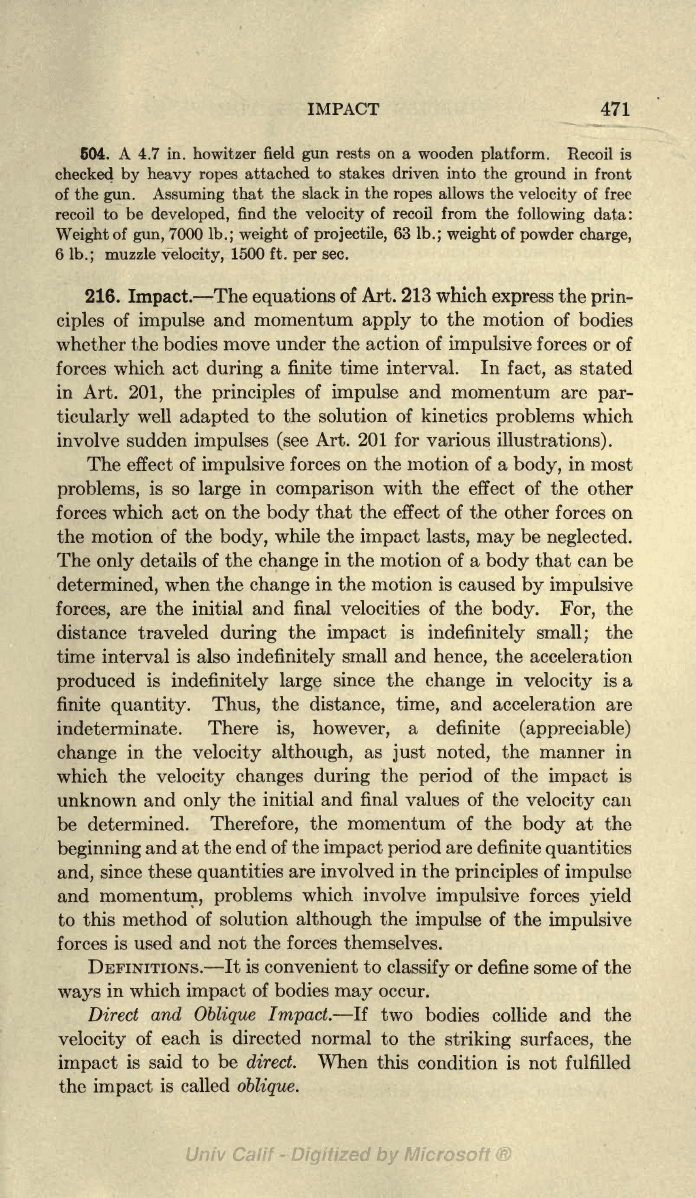
IMPACT
471
604.
A 4.7 in. howitzer
field
gun
rests on
a
wooden
platform.
Recoil is
checked
by heavy
ropes
attached
to stakes driven
into the
ground
in
front
of
the
gun.
Assuming
that
the slack
in the
ropes
allows
the
velocity
of
free
recoil to be
developed,
find the
velocity
of recoil from
the
following
data:
Weight
of
gun,
7000
lb.;
weight
of
projectile,
63
lb.;
weight
of
powder
charge,
6
lb.;
muzzle
velocity,
1500
ft.
per
sec.
216.
Impact.
The
equations
of
Art. 213
which
express
the
prin-
ciples
of
impulse
and
momentum
apply
to the
motion of
bodies
whether the
bodies move
under the action
of
impulsive
forces or
of
forces which
act
during
a finite time interval.
In
fact,
as
stated
in
Art.
201,
the
principles
of
impulse
and
momentum are
par-
ticularly
well
adapted
to the solution
of
kinetics
problems
which
involve
sudden
impulses
(see
Art. 201 for various
illustrations).
The effect
of
impulsive
forces on the
motion of a
body,
in most
problems,
is so
large
in
comparison
with the
effect
of
the other
forces which act
on the
body
that
the
effect of
the other
forces on
the motion of the
body,
while the
impact
lasts, may
be
neglected.
The
only
details
of the
change
in the motion
of a
body
that can
be
determined,
when
the
change
in
the motion is caused
by impulsive
forces,
are
the initial and final
velocities of
the
body.
For,
the
distance traveled
during
the
impact
is
indefinitely
small;
the
time interval is
also
indefinitely
small and
hence,
the acceleration
produced
is
indefinitely
large
since
the
change
in
velocity
is
a
finite
quantity.
Thus,
the
distance, time,
and
acceleration are
indeterminate.
There
is, however,
a definite
(appreciable)
change
in
the
velocity
although,
as
just
noted,
the
manner
in
which the
velocity changes
during
the
period
of the
impact
is
unknown
and
only
the
initial and final
values
of
the
velocity
can
be
determined.
Therefore,
the momentum of
the
body
at the
beginning
and at
the end
of the
impact period
are definite
quantities
and,
since
these
quantities
are involved
in
the
principles
of
impulse
and
momentum, problems
which involve
impulsive
forces
yield
to
this
method of
solution
although
the
impulse
of
the
impulsive
forces
is
used and not the
forces
themselves.
DEFINITIONS.
It is convenient to
classify
or
define some
of the
ways
in which
impact
of
bodies
may
occur.
Direct
and
Oblique Impact.
If
two
bodies collide and
the
velocity
of each
is
directed normal
to
the
striking
surfaces,
the
impact
is said
to
be
direct. When
this
condition is
not fulfilled
the
impact
is called
oblique.
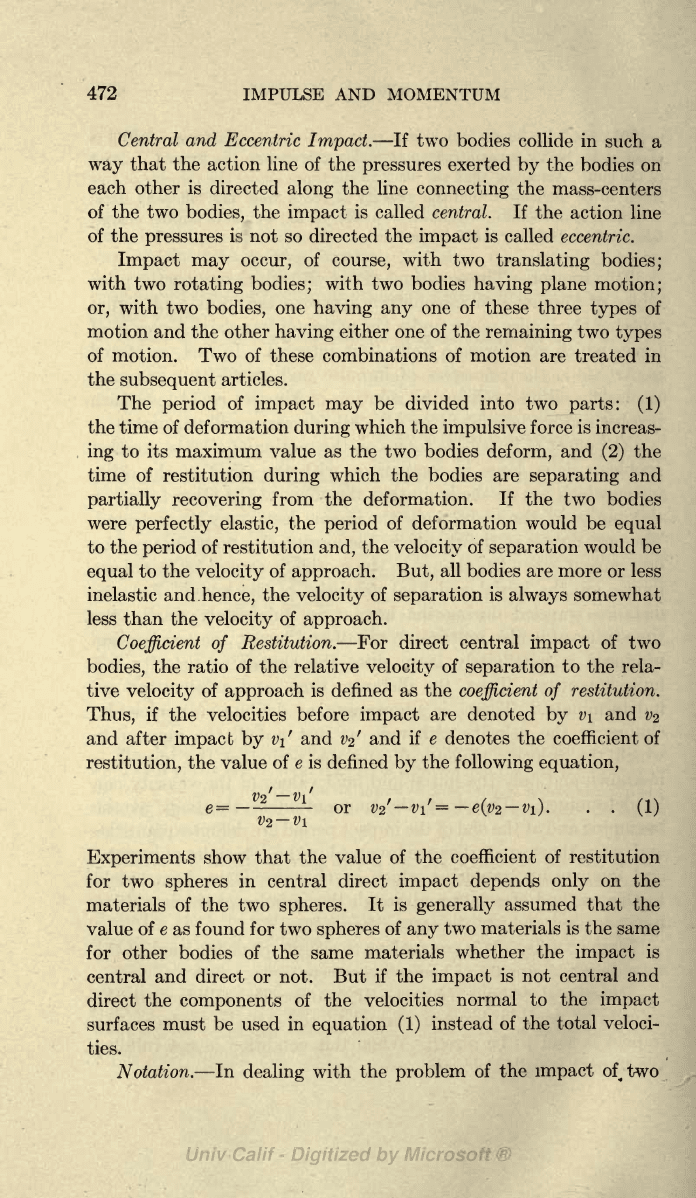
472
IMPULSE AND
MOMENTUM
Central
and
Eccentric
Impact.
If two
bodies
collide in
such
a
way
that
the
action
line of the
pressures
exerted
by
the bodies
on
each
other is
directed
along
the line
connecting
the
mass-centers
of
the two
bodies,
the
impact
is called central. If
the action
line
of the
pressures
is not so directed the
impact
is called
eccentric.
Impact may occur,
of
course,
with two
translating
bodies;
with
two
rotating
bodies;
with two bodies
having
plane
motion;
or,
with two
bodies,
one
having any
one of
these three
types
of
motion
and the other
having
either one of the
remaining
two
types
of motion. Two
of
these combinations
of
motion are treated in
the
subsequent
articles.
The
period
of
impact may
be
divided into
two
parts: (1)
the time of deformation
during
which the
impulsive
force
is
increas-
ing
to its maximum value as the two bodies
deform,
and
(2)
the
time of restitution
during
which
the bodies are
separating
and
partially recovering
from
the
deformation.
If
the two bodies
were
perfectly elastic,
the
period
of deformation would be
equal
to
the
period
of restitution
and,
the
velocity
of
separation
would be
equal
to the
velocity
of
approach.
But,
all bodies are more
or
less
inelastic
and
hence,
the
velocity
of
separation
is
always
somewhat
less than
the
velocity
of
approach.
Coefficient
of
Restitution.
For
direct central
impact
of two
bodies,
the
ratio of the relative
velocity
of
separation
to the rela-
tive
velocity
of
approach
is denned
as the
coefficient
of
restitution.
Thus,
if
the velocities
before
impact
are denoted
by
v\
and
V2
and
after
impact by
v\
and
v^,'
and
if
e denotes the coefficient of
restitution,
the value
of e
is
defined
by
the
following equation,
1)2
V\
. . , s
/1X
e=
or
V2 vi
=
e(V2
vi).
. .
(1)
V2
Vi
Experiments
show
that the value of the
coefficient
of
restitution
for
two
spheres
in central direct
impact
depends only
on
the
materials of the two
spheres.
It is
generally
assumed that
the
value of
e
as found for two
spheres
of
any
two
materials is the same
for other bodies of the same
materials
whether
the
impact
is
central
and direct or not. But
if the
impact
is not central and
direct
the
components
of the velocities
normal to
the
impact
surfaces
must be used in
equation
(1)
instead
of the
total veloci-
ties.
Notation.
In
dealing
with
the
problem
of the
impact
of^two
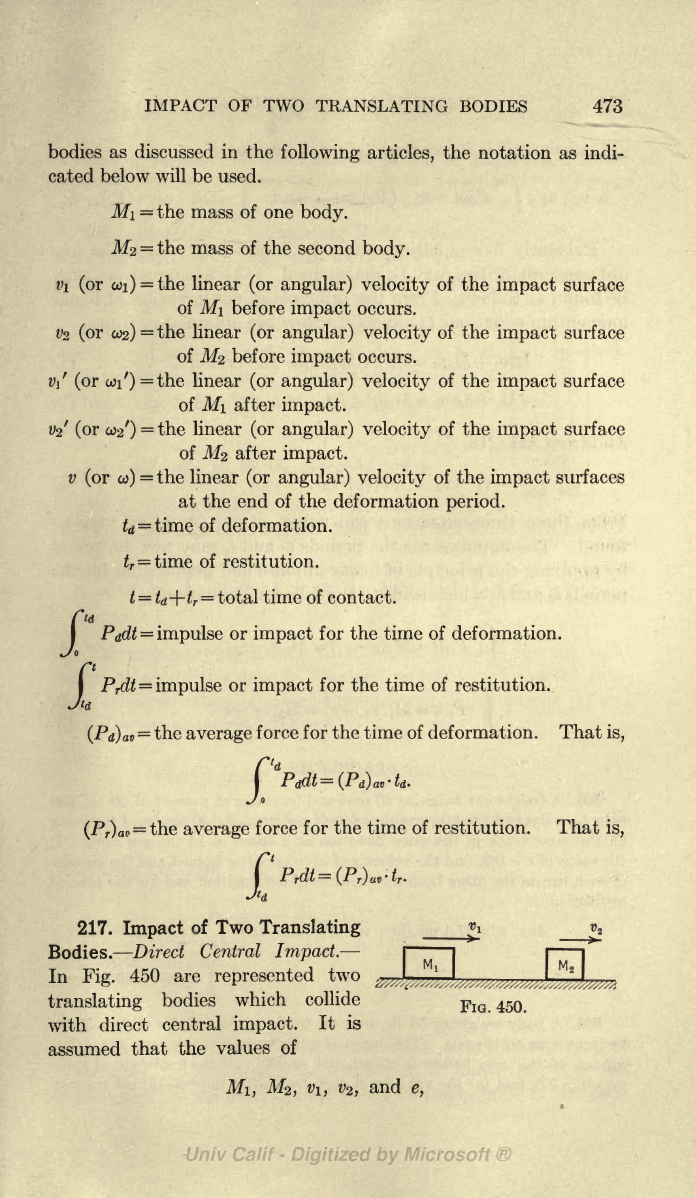
IMPACT OF TWO
TRANSLATING
BODIES
473
bodies as
discussed
in
the
following articles,
the
notation as indi-
cated below
will
be used.
MI
=
the
mass of one
body.
M2
=
the
mass of the second
body.
vi
(or o>i)
=
the linear
(or
angular)
velocity
of
the
impact
surface
of
MI
before
impact
occurs.
V2
(or 0)2)
=
the linear
(or
angular) velocity
of
the
impact
surface
of
A/2
before
impact
occurs.
v\
(or ooi')=the
linear
(or
angular) velocity
of the
impact
surface
of
MI
after
impact.
V2
(or
0)2')
=
the linear
(or angular)
velocity
of the
impact
surface
of
M2
after
impact.
v
(or co)
=
the
linear
(or angular) velocity
of
the
impact
surfaces
at the end
of the
deformation
period.
t
d
=
time
of
deformation.
jf
t
T
=
time
of
restitution.
t
=
t
d
-\-tr
=
total time of
contact.
P
d
dt
=
impulse
or
impact
for
the time of deformation.
r
I
P
r
dt
=
impulse
or
impact
for the time of restitution.
Jt
d
(P
d
)
ap
=
the
average
force
for
the
time of
deformation.
That
is,
td
p
d
dt=(P
d
)
av
-t
d
.
(P
r}
av
=
the
average
force
for the
time of
restitution.
That
is,
217.
Impact
of
Two
Translating
i
Bodies.
Direct
Central
Impact.
I 1
i
i
M!
j
I
M
2
I
In
Fig.
450
are
represented
two
^
X
J^^J^^^^
translating
bodies
which
collide
FIG. 450.
with
direct
central
impact.
It is
assumed
that
the
values
of
MI,
M2,
vi,
V2,
and
e,
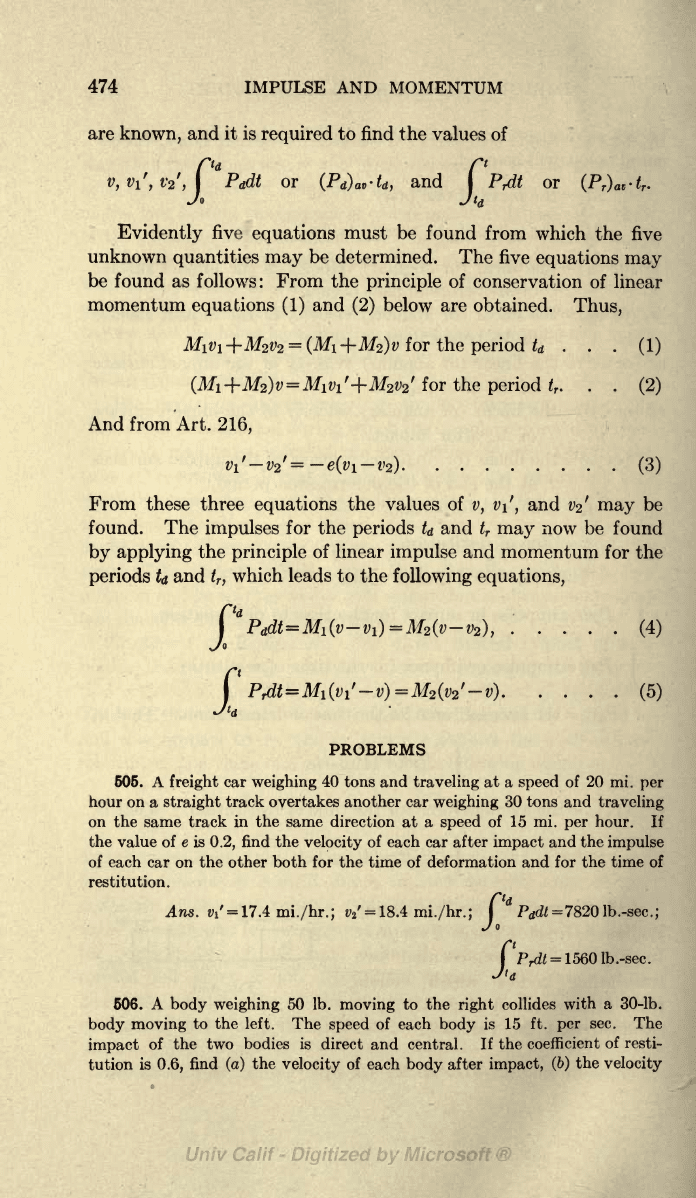
474
IMPULSE AND
MOMENTUM
are
known,
and it is
required
to find the
values
of
v,
vi
f
,
v
2
,
|
*Padt
or
(P
d
)
avt
d
,
and
|
P4t
or
Jo
Jt
d
Evidently
five
equations
must be
found
from
which
the
five
unknown
quantities
may
be
determined. The
five
equations
may
be
found
as follows:
From the
principle
of
conservation of linear
momentum
equations
(1)
and
(2)
below are
obtained.
Thus,
MI
vi +M
2
v
2
=
(Mi+M
2
)v
for
the
period
t
d
. . .
(1)
(Mi+M
2
)v
=
Miv
1 '+M
2
v
2
'
for
the
period
t
r
.
. .
(2)
And from Art.
216,
v\
v
2
'
=
e(vi
v
2
)
(3)
From these three
equations
the values of
v
t vi',
and
v
2
f
may
be
found. The
impulses
for the
periods
t
d
and
t
r
may
now be
found
by applying
the
principle
of linear
impulse
and
momentum for
the
periods
td
and
t
r
,
which leads to the
following
equations,
JT
/
P
d
dt=M
1
(v-vi)=M
2
(v-v
2
),
(4)
P4t=Mi(vi'-v)=M2(v2
f
-v)
(5)
PROBLEMS
506. A
freight
car
weighing
40 tons and
traveling
at
a
speed
of 20
mi.
per
hour
on
a
straight
track
overtakes another car
weighing
30 tons
and
traveling
on the same track
in the
same
direction
at a
speed
of
15 mi.
per
hour. If
the
value of
e
is
0.2,
find
the
velocity
of each car after
impact
and
the
impulse
of
each car on the other both for the time of deformation and for
the time of
restitution.
Ans.
vi'
=
17.4
mi./hr.;
v
2
'
=
18.4
mi./hr.;
(
&
P
d
dt
=
7820
Ib.
-sec.;
Jo
JC
506. A
body
weighing
50 Ib.
moving
to the
right
collides
with
a 30-lb.
body
moving
to the
left. The
speed
of each
body
is
15
ft.
per
sec. The
impact
of
the two
bodies is
direct
and central.
If the
coefficient
of
resti-
tution
is
0.6,
find
(a)
the
velocity
of
each
body
after
impact,
(6)
the
velocity
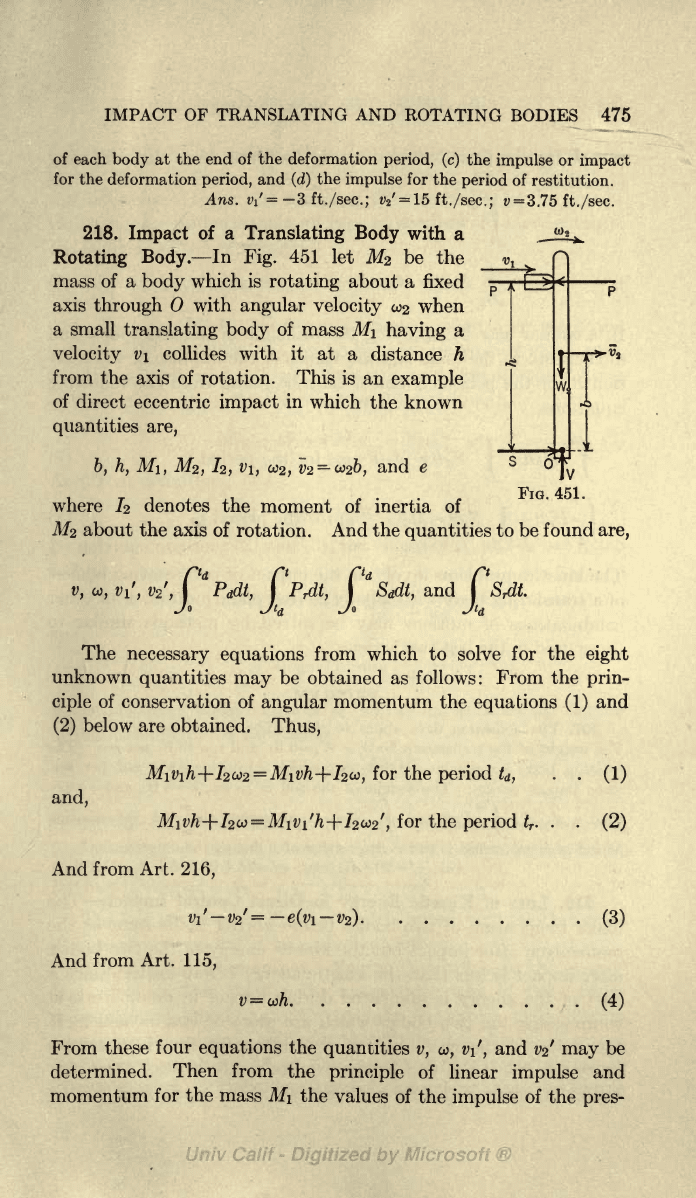
IMPACT OF TRANSLATING AND
ROTATING BODIES
475
IT
5
'
of each
body
at
the end of
the
deformation
period,
(c)
the
impulse
or
impact
for the
deformation
period,
and
(d)
the
impulse
for the
period
of
restitution.
Ans.
vi=
3 ft.
/sec.;
v
2
'
=
l5
ft.
/sec.;
v
=
3.75
ft.
/sec.
218.
Impact
of a
Translating Body
with
a
Rotating
Body.
In
Fig.
451
let M
2
be
the
mass of a
body
which
is
rotating
about a
fixed
axis
through
with
angular
velocity
002
when
a small
translating body
of
mass
MI
having
a
velocity
v\
collides with it at
a
distance h
from
the axis of
rotation.
This
is
an
example
of
direct
eccentric
impact
in
which
the
known
quantities
are,
6,
h,
MI,
M2,
/2, #1,
co2,
v
2
u
2
b,
and e
where I
2
denotes
the
moment
of
inertia of
M
2
about the
axis of
rotation.
And
the
quantities
to be found
are,
v,
co,
vi'
t
The
necessary
equations
from which to solve
for the
eight
unknown
quantities may
be obtained as
follows:
From the
prin-
ciple
of
conservation of
angular
momentum the
equations
(1)
and
(2)
below
are
obtained.
Thus,
and,
And
from Art.
216,
And
from
Art.
115,
c
l
j,
for
the
period
t
d
,
.
.
(1)
,
for
the
period
t
r
. . .
(2)
(3)
(4)
From
these
four
equations
the
quantities v,
co, v\,
and
v
2
r
may
be
determined.
Then from
the
principle
of
linear
impulse
and
momentum
for
the
mass
MI
the
values of
the
impulse
of the
pres-

476
IMPULSE
AND
MOMENTUM
sure
P
for
the
periods
t
d
and t
r
may
be
found from
the
following
equations,
f
I
=
Mi(v vi)
for the
period
t
d
,
...
(5)
P
r
d*
=
Mi
fa
'
-
w)
for
the
period
t
r
.
...
(6)
In
a similar
way by
applying
the
principle
of
linear
impulse
and
momentum
to
the mass
M<,
the
values of the
impulse
of the
reac-
tion
S for the
periods
t
d
and
t
r
may
be
found
from the
following
equations,
Ai
Ai
I
P
d
dt+
I
S
d
dl
=
M2(v V2)
for the
period fo,
...
(7)
J
P^+
J
Srdt
=
M
2
(v2
f
-v)
for
the
period
Z
r
.
...
(8)
x
'd
x
'd
The
kinetics
problems
involving
the
impact
of two
rotating bodies,
of
a
translating body
with
a
body having plane motion,
or of other
combinations
of
motions
may
be solved
by
methods similar
to
those
used
in the last two articles.
PROBLEM
607.
The
following
data
apply
to the bodies
represented
in
Fig.
451.
The
weight
of
the
translating
body
is
W\=Q
Ib. and
vi=40
ft.
per
sec.
The
rotating body
is a
slender rod 6 ft.
long
which
is
rotating
at
4
rad.
per
sec.
when
impact
occurs.
The
weight
of
the rod is 15
Ib.,
h
=
5
ft.,
and
e
=
0.8.
Find
v, v'i, v'%,
I;
P
d
dt and I S
d
dt.
Assuming
that
the
deformation
Jo
Jo
period
is
TO
sec.,
what
is the
average
value of
S
during
the
deformation?
Ans.
v
1
/
=
20.4ft./sec.;
t*'
=
36.4
ft./sec.;
S
av
=
5.l Ib.
219. Loss of Kinetic
Energy
in Direct Central
Impact.
The
linear momentum of two
bodies before
impact
is the same as
the
momentum
after
impact
but the kinetic
energy
of
the two
bodies
after
impact
is
less than
the kinetic
energy
before
impact
since
a
part
of
the
energy
is
dissipated during impact
in
doing
work
in
compressing
the two
bodies
which
are more
or
less
inelastic.
If
the value
of the coefficient of restitution
for two
bodies
were
unity,
that
is
if
the two bodies
were
perfectly
elastic,
no
energy
would
be
dissipated
during impact
since
the work
done
in
the
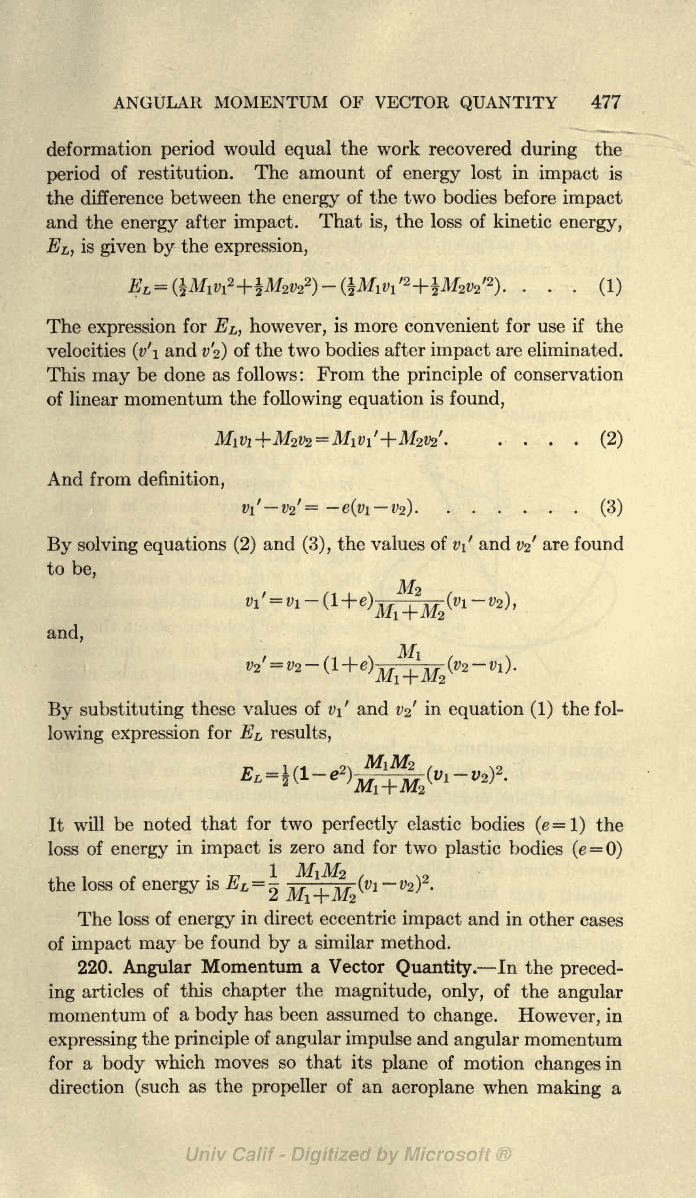
ANGULAR
MOMENTUM
OF
VECTOR
QUANTITY
477
deformation
period
would
equal
the
work recovered
during
the
period
of restitution.
The amount of
energy
lost in
impact
is
the difference
between
the
energy
of
the two bodies
before
impact
and the
energy
after
impact.
That
is,
the loss of
kinetic
energy,
E
L
,
is
given by
the
expression,
E
L
=$M
l
v
l
2
+M
2V2
2
)-(}iMiVi'
2
+W2V2'
2
).
. .
.
(1)
The
expression
for
E
L
, however,
is more convenient for use if the
velocities
(2/1
and
2/2)
of the two
bodies after
impact
are
eliminated.
This
may
be
done as follows:
From the
principle
of
conservation
of
linear momentum
the
following
equation
is
found,
(2)
And from
definition,
Vl
'-v
2
'=-e(v
1
-v
2
)
.......
(3)
By solving
equations
(2)
and
(3),
the
values of
v\
and v
2
are found
to
be,
M
2
a'T^-a-N^
and,
By
substituting
these values
of
v\
and
v
2
'
in
equation
(1)
the fol-
lowing
expression
for
E
L
results,
It
will
be
noted
that
for two
perfectly
elastic
bodies
(e=l)
the
loss
of
energy
in
impact
is zero and for
two
plastic
bodies
(e
=
0)
the
loss
of
energy
is
E
L
=
-
M \^
(vi~v
2
)
2
.
The
loss
of
energy
in
direct eccentric
impact
and in
other
cases
of
impact
may
be
found
by
a similar
method.
220.
Angular
Momentum a Vector
Quantity.
In
the
preced-
ing
articles
of
this
chapter
the
magnitude,
only,
of the
angular
momentum
of
a
body
has been
assumed to
change.
However,
in
expressing
the
principle
of
angular impulse
and
angular
momentum
for a
body
which
moves so
that its
plane
of
motion
changes
in
direction
(such
as
the
propeller
of
an
aeroplane
when
making
a
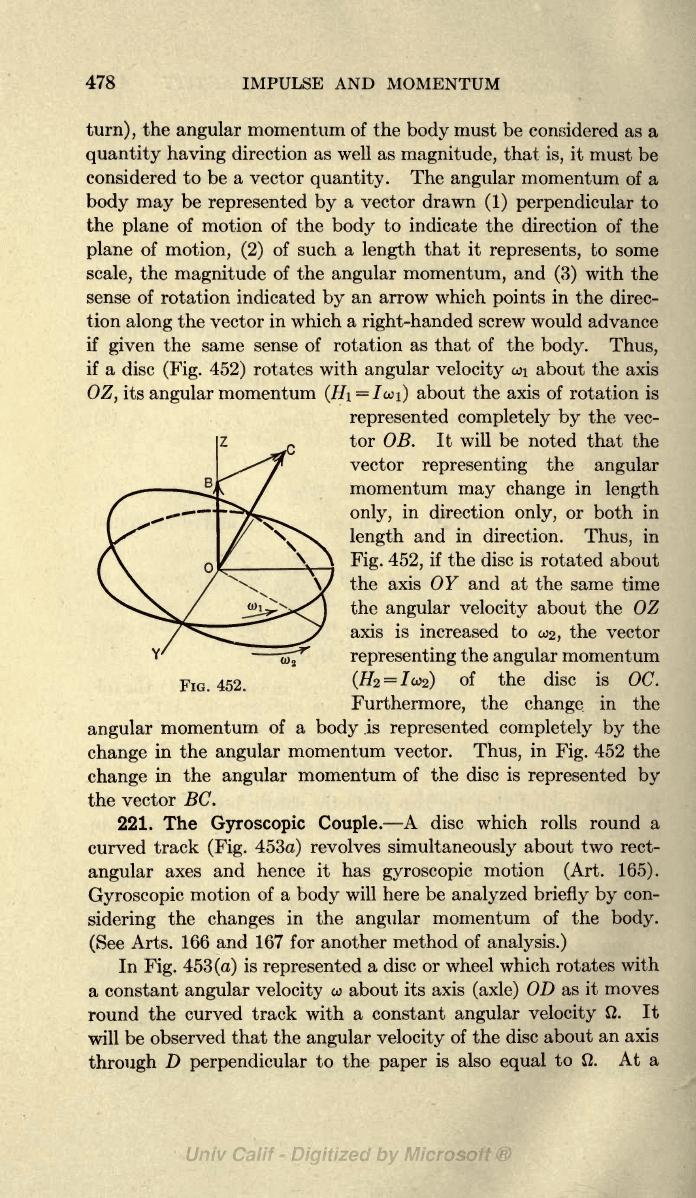
478
IMPULSE AND
MOMENTUM
turn),
the
angular
momentum of
the
body
must be
considered
as
a
quantity
having
direction as
well as
magnitude,
that
is,
it
must
be
considered to be a
vector
quantity.
The
angular
momentum
of
a
body may
be
represented
by
a vector
drawn
(1)
perpendicular
to
the
plane
of motion of the
body
to indicate the
direction of
the
plane
of
motion, (2)
of such
a
length
that it
represents,
fco
some
scale,
the
magnitude
of the
angular momentum,
and
(3)
with the
sense
of rotation indicated
by
an arrow which
points
in
the direc-
tion
along
the vector
in
which
a
right-handed
screw
would
advance
if
given
the same sense of
rotation as that of the
body.
Thus,
if
a
disc
(Fig.
452)
rotates with
angular
velocity
coi
about
the
axis
OZ,
its
angular
momentum
(HiIwi)
about the
axis
of
rotation is
represented completely
by
the
vec-
tor OB. It will be
noted
that the
vector
representing
the
angular
momentum
may
change
in
length
only,
in
direction
only,
or both in
length
and
in
direction.
Thus,
in
Fig.
452,
if the disc
is
rotated about
the axis OY
and at
the
same time
the
angular velocity
about the OZ
axis
is increased to
002,
the
vector
representing
the
angular
momentum
(H
2
=
Iw2)
of
the disc
is OC.
Furthermore,
the
change
in
the
angular
momentum
of a
body
is
represented
completely by
the
change
in the
angular
momentum vector.
Thus,
in
Fig.
452 the
change
in
the
angular
momentum of the
disc is
represented
by
the vector
BC.
221. The
Gyroscopic Couple.
A
disc which rolls round a
curved
track
(Fig.
453a)
revolves
simultaneously
about two rect-
angular
axes
and hence it
has
gyroscopic
motion
(Art.
165).
Gyroscopic
motion of a
body
will
here be
analyzed briefly
by
con-
sidering
the
changes
in the
angular
momentum
of the
body.
(See
Arts. 166
and 167 for another
method of
analysis.)
In
Fig.
453
(a)
is
represented
a disc or wheel
which
rotates
with
a
constant
angular velocity
co
about
its axis
(axle)
OD as
it
moves
round
the
curved track with a
constant
angular
velocity
ft.
It
will
be
observed
that
the
angular
velocity
of the
disc
about
an axis
through
D
perpendicular
to the
paper
is also
equal
to
ft. At a
FIG.
452.
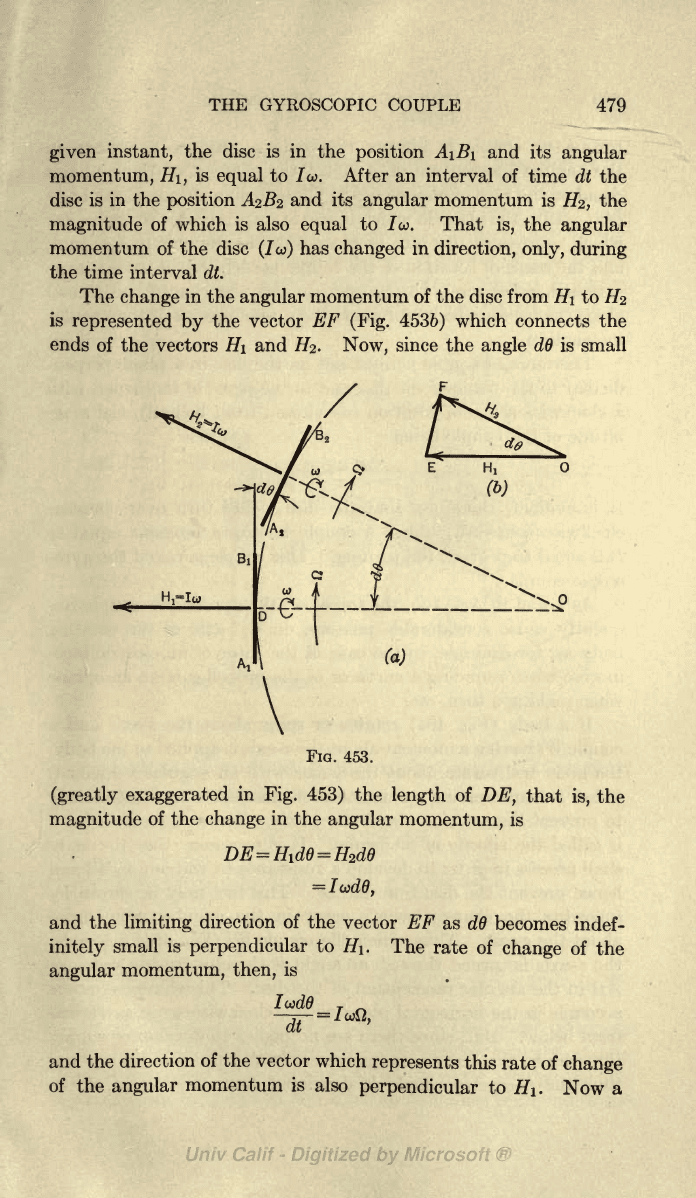
THE
GYROSCOPIC
COUPLE
479
given
instant,
the disc is
in
the
position
A\Bi
and
its
angular
momentum, H\,
is
equal
to 7co. After
an interval of
time
dt the
disc
is
in
the
position
A^B^
and its
angular
momentum
is
#2,
the
magnitude
of
which
is also
equal
to
Jco.
That
is,
the
angular
momentum
of
the disc
(7o>)
has
changed
in
direction,
only,
during
the time
interval
dt.
The
change
in
the
angular
momentum of the disc
from
HI
to
Hz
is
represented
by
the
vector EF
(Fig.
4536)
which
connects the
ends
of the
vectors
HI
and
#2.
Now,
since the
angle
dd
is small
FIG.
453.
(greatly
exaggerated
in
Fig. 453)
the
length
of
DE,
that
is,
the
magnitude
of the
change
in
the
angular
momentum,
is
and
the
limiting
direction
of
the
vector
EF
as
dd
becomes
indef-
initely
small
is
perpendicular
to
H\.
The
rate of
change
of
the
angular
momentum,
then,
is
dt
and the
direction
of the vector
which
represents
this
rate of
change
of
the
angular
momentum is
also
perpendicular
to
HI.
Now
a
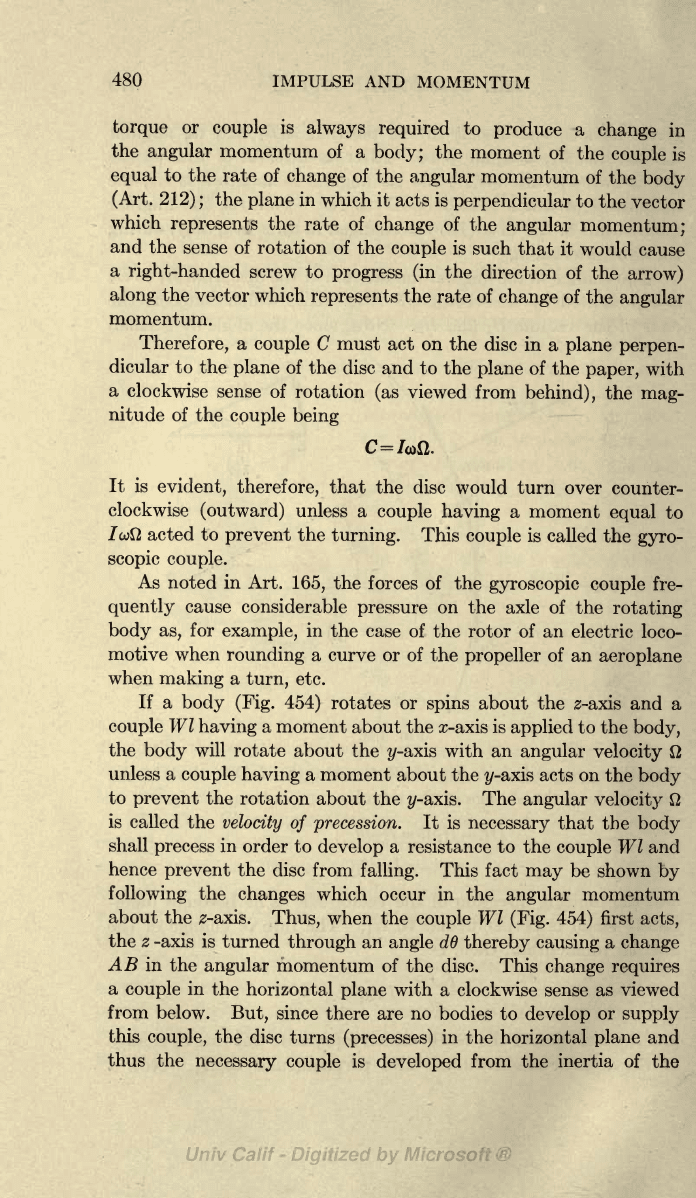
480
IMPULSE
AND
MOMENTUM
torque
or
couple
is
always
required
to
produce
a
change
in
the
angular
momentum
of a
body;
the
moment of
the
couple
is
equal
to
the
rate of
change
of
the
angular
momentum
of
the
body
(Art.
212)
;
the
plane
in
which it acts is
perpendicular
to
the
vector
which
represents
the
rate
of
change
of
the
angular
momentum;
and
the
sense of
rotation of
the
couple
is
such
that it
would
cause
a
right-handed
screw
to
progress (in
the
direction
of
the
arrow)
along
the
vector
which
represents
the rate of
change
of
the
angular
momentum.
Therefore,
a
couple
C must act on
the
disc in
a
plane
perpen-
dicular
to
the
plane
of the
disc and to
the
plane
of
the
paper,
with
a
clockwise
sense of
rotation
(as
viewed from
behind),
the
mag-
nitude of the
couple
being
It
is
evident,
therefore,
that the disc
would turn over
counter-
clockwise
(outward)
unless
a
couple
having
a
moment
equal
to
7col2 acted to
prevent
the
turning.
This
couple
is
called the
gyro-
scopic
couple.
As noted
in
Art.
165,
the
forces of
the
gyroscopic
couple
fre-
quently
cause
considerable
pressure
on the
axle of
the
rotating
body as,
for
example,
in
the case of the rotor
of an
electric
loco-
motive when
rounding
a
curve or of
the
propeller
of
an
aeroplane
when
making
a
turn,
etc.
If a
body
(Fig. 454)
rotates or
spins
about
the
2-axis
and a
couple
Wl
having
a
moment about the
z-axis
is
applied
to the
body,
the
body
will rotate
about
the
?/-axis
with
an
angular
velocity
12
unless a
couple
having
a
moment about the
?/-axis
acts on
the
body
to
prevent
the
rotation
about
the
y-axis.
The
angular
velocity
12
is
called
the
velocity
of
precession.
It is
necessary
that the
body
shall
precess
in
order to
develop
a resistance to
the
couple
Wl
and
hence
prevent
the disc
from
falling.
This
fact
may
be shown
by
following
the
changes
which occur in the
angular
momentum
about
the
z-axis.
Thus,
when the
couple
Wl
(Fig. 454)
first
acts,
the
z
-axis
is
turned
through
an
angle
dd
thereby
causing
a
change
AB
in
the
angular
momentum of the disc. This
change
requires
a
couple
in
the
horizontal
plane
with a
clockwise sense
as viewed
from
below.
But,
since there are no
bodies
to
develop
or
supply
this
couple,
the
disc
turns
(precesses)
in
the horizontal
plane
and
thus
the
necessary couple
is
developed
from
the
inertia
of
the
